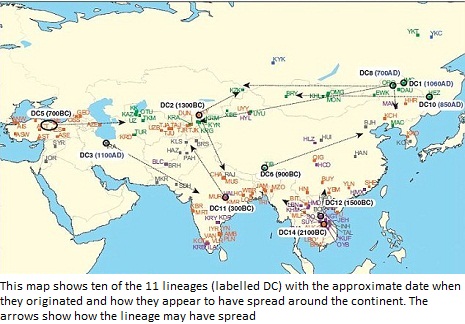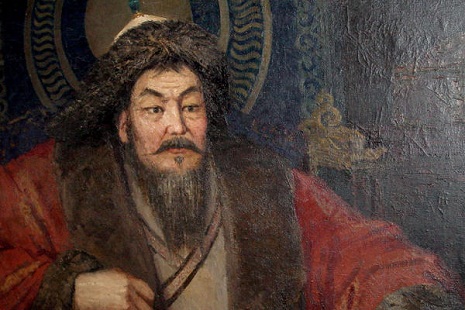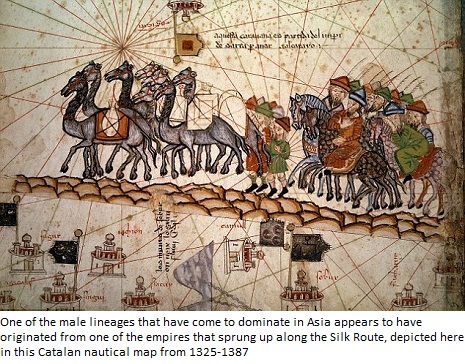Geneticists have been able to find eleven distinctive sequences in Y-chromosomes - the chunk of DNA that is only carried by men - that are persistent in modern populations in Asia.
By systematically analysing the DNA of more than 5,000 men, they have been able to trace these male lineages to their approximate `founding fathers`.

They found that along with Khan, who is reputed to have sired hundreds of children as his hoards cut a swathe across much of Asia, they traced ten other lineages.
These are thought to originate from the Middle East to Southeast Asia between 2100BC and 1100AD.
They found that 37.8 per cent of the 5,000 men they tested belonged to one of these eleven lineages.
If this is reflected in the entire Asian population, then it could mean around 830 million men living in Asia currently owe their Y-chromosomes to one of these eleven men.
Among them is a lineage that has previously been attributed to a Chinese ruler called Giocangga, who died in 1583 and whose grandson founded the Qing Dynasty that ruled China between 1644 and 1912.
Giocangga is thought to have had many children with his wives and concubines and is the direct male ancestor of more than 1.5 million men.
The researchers also found that another of the lineages appears to have population clusters that are concentrated along the Silk Road trading route and date back to around 850AD.
This suggests they may have their origins among the powerful rulers who dominated the steppes where the route passed - the Khitan, Tangut Xia, Juchin, Kara-Khitan and Mongol empires.
The researchers suggest that Abaoji, Emperor Taizu of Liao and the Great Khan of the Khitans, who died in 926AD in the Khitan area of China, is a possible candidate for the father of this lineage.
Professor Mark Jobling, a geneticist at the University of Leicester who led the work, which is published in the European Journal of Human Genetics, said that more research was needed before they could identify the individuals.
The founding fathers who lived between 2100BC and 300BC appear to have existed in both sedentary agricultural societies and nomadic tribes, he added.

Writing in the European of Human Genetics, he said: `High reproductive success is often associated with high social status, ‘prestigious’ men having higher intramarital fertility, lower offspring mortality and access to a greater than average number of wives.
`Those with recent origins in the historical period are almost exclusively found in Altaic-speaking pastoral nomadic populations, which may reflect a shift in political organisation in pastoralist economies and a greater ease of transmission of Y-chromosomes through time and space facilitated by the use of horses.
`New social systems and economic adaptations emerged after horse domestication.
`Horse-riding greatly enhanced both east–west connections and north–south trade between Siberia and southerly regions, and allowed new techniques of warfare, a key element explaining the successes of mobile pastoralists in their conflicts with more sedentary societies.`

The researchers analysed the Y chromosomes of 5,321 men from 127 different populations around Asia.
They found 11 common Y chromosome sequences that cropped up repeatedly in the genomes they examined.
By searching these for distinctive random mutations that accumulate over time they were able to estimate roughly when these Y chromosome sequences originated.
Looking at the distribution of these sequences in the populations they tested also allowed them to estimate where they may have originated by looking for clusters.
Previous research conducted in 2003 had shown that almost 16 million men across the world could be related to the Mongol leader Genghis Khan, who died in 1227.
Scientists traced a cluster of extremely similar Y-chromosomes back to a single ancestor living in Mongolia around 800 years ago.
They believe the only man with the opportunity to father enough children would have been the Mongolian warlord.
Within 80 years he built an empire that covered much of China, Iran, Pakistan, Korea and South Russia.
The empire he founded went on to stretch across much of Asia and into Europe, meaning there was potential for his descendants to spread his genes far and wide.
Tom Robinson, an accountancy professor whose ancestors came from the Lake District, was the first man outside Asia to be identified as carrying the Khan chromosome.
It was found that Professor Robinson`s paternal forebears came from the Caucasus near the Black Sea.
Similar work found Giocangga was also the most probably origin of another distinct Y chromosome found in modern China and Mongolia.
However, tracing the other dominant Y chromosomes to other individuals will require similar educated guesswork by looking for men who had the power and potential to sire large numbers of children at around the right time that the sequences are found to originally occur.

GENGHIS KHAN AND THE RISE OF THE MONGOL EMPIRE
Genghis Khan was the founder and Great Khan of the Mongol Empire.
In the early 1200s he united the tribes, creating a military state that invaded its neighbours and expanded, soon ruling most of what would become modern Korea, China, Russia, eastern Europe, southeast Asia, Persia and India.
Khan made himself master of half the known world, and inspired mankind with a fear that lasted for generations.
He was a prolific lover, fathering hundreds of children across his territories. Some scientists think he has 16 million male descendants alive today.
By the time he died in August 1227, the Mongol Empire covered a vast part of Central Asia and China.
Originally known as Temüjin of the Borjigin, legend has it Genghis was born holding a clot of blood in his hand.
His father was Khan, or emperor, of a small tribe but was murdered when Temüjin was still young.
The new tribal leader wanted nothing to do with Temujin`s family, so with his mother and five other children, Temüjin was cast out and left to die.
In all, Genghis conquered almost four times the lands of Alexander the Great. He is still revered in Mongolia and in parts of China.
___
One of the `founding fathers` appears to have lived in what is now northern Turkey in 700BC while another came from Iran in around 1100AD.
Others seem to originate around 2100BC and 1500BC in southeast Asia. Around this time farming populations were moving down through Burma into Laos, Thailand and Cambodia, leading to the Mon and Khmer empires.
The only way to know for sure who these 11 founding fathers were will be to find their remains and extract DNA.
If the tomb of leaders like Genghis Khan are ever unearthed, it could result in the ultimate paternity test for millions of men around the world.
Chris Tyler-Smith, an evolutionary geneticist now at the Wellcome Trust Sanger Institute in Hinxton, UK, who led that orginal study in 2003, told Nature: `Looking for these links is fascinating.
`When we did it, we were using pretty indirect lines of reasoning, and you could try and do that with each of these lineages.
`What I really hope is that at some point someone will find Genghis Khan`s tomb and remains.`
















































